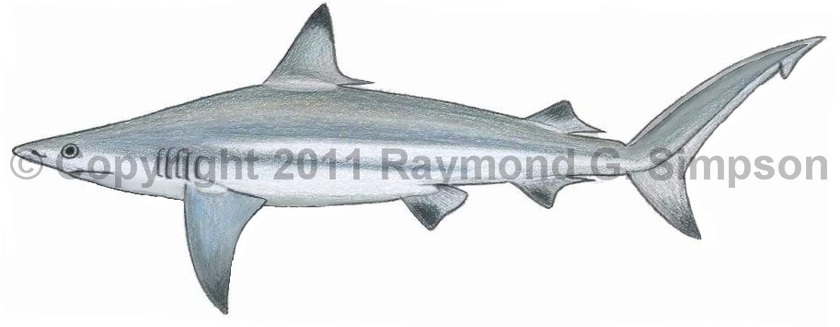
Common Name
Blacktip Shark
Year Described
Müller and Henle, 1839
Identification
Anteroposterior tooth rows: 14-16/13-15 on each side; 29-35/27-33 total
Vertebrae: 88-102 precaudal, 174-203 total
A fairly large and slender shark with a long and pointed snout. Eye small. Distance between nostrils 1.3-1.7 times in pre-oral distance. Nasal flaps broadly triangular and low. Upper labial furrows short. Interdorsal ridge is absent. Long preanal ridge absent. No keels on caudal peduncle. Gill slits very long (3.8-4.9% TL). Teeth in upper jaws broad based and serrated, with a narrow, erect cusp. Lower jaw teeth broad-based and serrated, with narrow, erect cusps. First dorsal fin high (8.2-12.4% TL) with a convex or straight anterior margin, a pointed tip, and inserted just posterior to origin of pectoral fin. Second dorsal fin much smaller (2.5-3.6% TL) and inserted almost directly above anal fin. Both dorsal fins with extended free posterior tips (second dorsal free tip less than twice height of second dorsal). Anal fin similar in size to second dorsal fin. Pelvic fin origin well behind free tip of first dorsal. Pectoral fin long and falcate, with a pointed tip.
Color
Dark gray, blue, or bronze above, abruptly whitish below. Dorsal pigment extends into white area as a lateral stripe that extends from above pectoral fin to the pelvic fin. Fins with dark tips in juveniles, but fading to dusky in adults with only the pelvic tip remaining dark.
Size
Mature adults from 120-190cm TL. Newborns from 55-72cm. Maximum size to 250cm TL.
Habitat
Coastal to offshore near dropoffs, usually in less than 30m. Most common in nearshore waters and estuaries. Can tolerate brackish water but never in fresh water.
Range
New England to S. Brazil, including the Gulf of Mexico and the Caribbean Sea.
References
Castro, J.I. 2011. The Sharks of North America. Oxford University Press, 640 pp.
Compagno, L.J.V. 2002. Sharks. In: Carpenter, K.E. (Editor) FAO Identification Guide for Fishery Purposes. The Living Marine Resources of The Western Central Atlantic. Volume 1: Introduction, mollusks, crustaceans, hagfishes, sharks, batoid fishes, and chimaeras. ASIH Special Publication No. 5. FAO, Rome.
Compagno, L., M. Dando, and S. Fowler. 2005. Sharks of the World. Princeton University Press, 480 pp.